Music is the universal language
“Glory to God in the highest heaven, and on earth peace to those on whom his favor rests.” - Luke 2:14
General Interest
James Bay on Failed Solos, Onstage Adrenaline, and How to Hire a Band

On this episode, James Bay joins Cory Wong from backstage at the 9:30 Club in Washington, D.C. (It takes Wong all of 10 seconds to recognize and name the green room.) Bay is still supporting his fourth full-length record, Changes All the Time, and Wong picked up on a different guitar approach on the new album. Bay walks him through how his playing matched the collection’s title.
Bay also reveals the first solo he learned to play (or, rather, failed to learn to play; it’s a Bon Jovi hit), and how Jack White’s philosophy of struggle against his instrument has shaped Bay’s relationship to his own guitars. As bandleaders, Wong and Bay both have plenty of experience hiring players to join them in studio and on the road, so what do they look for when selecting colleagues? Tune in to find out.
It wouldn’t be a chat with a Minnesotan guitarist without some Prince talk, so stick around to learn the appropriate etiquette for covering The Artist when touring his home state.
New “Broken-In” P-Bass Feels 60 Years Old
Realistic vintage-like wear on the neck and body of this rock-solid P-Bass make it feel as familiar as a favorite sweater.
Featuring a variety of vintage colors finished in Road Worn® aged nitrocellulose lacquer, the Vintera II Road Worn ‘60s Precision Bass recreates the look and feel of a well-played classic. The limited Road Worn models are enhanced with a new subtle aging process combining light checking, gentle wear patterns and a semi-gloss finish, while maintaining the authentic broken-in feel players love about vintage Fenders. The ‘60s “C”-shape maple neck with 7.25” radius rosewood fingerboard and vintage-tall frets provides supreme comfort and outstanding feel. Under the hood, you’ll find a vintage-style ‘60s split-coil Precision pickup that delivers all the warm, dynamic and powerful tone that made Fender famous. The vintage-style 4-saddle bridge and vintage-style tuning machines provide classic looks with enhanced intonation and tuning stability to complete the package. Options include Rosewood Fingerboard in Fiesta Red and Charcoal Frost Metallic.
“They used a lot of the old tricks that we all kind of did”: Aerosmith recall being ‘annoyed’ by Van Halen at first

When Van Halen burst onto the hard rock scene in the late ‘70s, they didn’t just make an impression, they shook the established order. For Aerosmith guitarists Joe Perry and Brad Whitford, their first encounter with the band was a mix of annoyance and awe.
In a recent interview with Rick Beato, the pair open up about their initial reactions to the group that would go on to redefine rock guitar.
Perry, in particular, admits he was initially baffled by Eddie Van Halen’s approach: “Well, first of all, it was kind of annoying,” he says [via Ultimate Guitar]. “It’s like, we didn’t know what he was doing. I mean, we knew a little bit about it. I remember Bill Lawrence used to do the tapping, when he’d sit and write… But it was like, damn… like the equivalent of Jeff Beck; somebody who was just kind of out of reach.”
But what frustrated him at first soon turned into admiration. “I mean, the more and more I listened to his stuff, it just blew my mind, because it’s so tasty. There was nothing schlocky ever in it.”
Whitford adds that Van Halen’s relentless work ethic and tight chemistry set them apart from their peers: “And the power, like when I read Alex’s [Van Halen] book – you read that, and then get an understanding how, day in and day out, they would get up in the morning, and go play together till midday, every day,” he explains.
“And then, you listen to these records, and you hear the lock that those two guys had, and the power that they had. It was like, ‘Whoa, that’s one of the most powerful bands I’ve ever heard.’”
For Perry, it wasn’t just the playing – it was the way Van Halen completely reimagined the hard rock formula.
“On that first record… When I heard that, it was like, they used a lot of the old tricks that we all kind of did and left behind. They took it, and turned it up to 11,” says the guitarist. “And that first album was fucking stunning… I remember, when they were playing clubs, that [Eddie] would turn around and do shit so people couldn’t see what he was doing. And, God, if people could see it, I don’t think they could do it anyway.”
Watch the full interview below.
The post “They used a lot of the old tricks that we all kind of did”: Aerosmith recall being ‘annoyed’ by Van Halen at first appeared first on Guitar.com | All Things Guitar.
Cort’s Earth GO packs traditional acoustic craftsmanship and modern smart tools – including looping, effects, and Bluetooth – into a compact travel guitar

Looking for a guitar that’s as at home on the road as it is on stage? Cort Guitars’ Earth GO combines traditional acoustic craftsmanship with intelligent, performance-focused features, delivering a portable, versatile instrument without compromising the tone musicians love.
Perfect for players seeking portability, creativity, and a modern edge, the Earth GO keeps the familiar feel of an acoustic guitar while adding a suite of smart tools for practice, recording, and live performance.
The Earth GO sports a 3/4 size mini dreadnought body, making it ideal for travel, casual playing, or players with smaller hands. Its solid Sitka spruce top delivers clarity and responsiveness, while mahogany back and sides deliver warmth and depth. According to Cort, this classic tonewood pairing ensures a balanced and resonant acoustic voice.
The guitar’s mahogany neck features a comfortable “C” profile and a 22.8” (578mm) scale length, complete with a laurel fingerboard with 6mm white dot inlays and a 15.75” radius. With a PPS nut (43mm wide) and 19 frets, the guitar offers accurate intonation and a natural playing feel.
 Credit: Cort Guitars
Credit: Cort Guitars
At the core of the Earth GO is the HyVibe H2 smart system, which turns the guitar into a mini performance hub. Built-in effects – reverb, chorus, delay, tremolo, octaver, phaser, and distortion – eliminate the need for external pedals. Players can stream backing tracks via Bluetooth, loop melodies, tune up with the onboard tuner, or keep time using the integrated metronome. Whether practicing at home or performing live, these intuitive tools offer unmatched creative freedom.
In terms of hardware, we’ve got die-cast tuning machines with black knobs, a dual-acting truss rod for easy neck adjustments, and a laurel bridge with a PPS saddle. The guitar also comes factory-equipped with coated strings for durability and playability, and each instrument includes a gig bag for added portability.
Available in Open Pore and Open Pore Brown Burst finishes, the Cort Earth GO can be picked from Thomann for $431 / £382.
Learn more at Cort Guitars.
The post Cort’s Earth GO packs traditional acoustic craftsmanship and modern smart tools – including looping, effects, and Bluetooth – into a compact travel guitar appeared first on Guitar.com | All Things Guitar.
“Dear UPS, where are my guitars?”: Johnny Marr slams UPS over “lost” guitars ahead of tour

Johnny Marr versus Morrissey is one thing, but Johnny Marr versus UPS? That’s a whole different headache.
Days before kicking off a short run of East Coast shows, the Smiths guitarist claims that UPS has misplaced several of his touring guitars – including at least one Fender and one Gibson.
Marr aired his frustrations on X, saying his gear vanished more than a week ago. “Dear UPS where are my guitars? They disappeared a week ago. I’m hearing from you now that they’ve been lost. Explain,” he writes.
Though what really set him off was the courier’s request for a description of the instruments.
“Asking me to describe what my guitars look like is not filling me with confidence,” Marr quips. “They look exactly like the ones you put in one of your delivery vans days ago. Remember?”
And just in case anyone at UPS needed more detail, Marr helpfully adds: “Look for one that says ‘80’s Icon’ on the case and another one that says ‘Woke As Fuck’”
The guitarist – whose devotion to six-strings even earned its own photo book, Marr’s Guitars (2023) – didn’t hold back on hashtags either, tagging Fender and Gibson along with a blunt #fuckUPSinc and #freemyguitars.
UPS is reportedly investigating the case, though as of writing there’s no sign of Marr’s missing gear. With his tour dates looming, here’s hoping those cases turn up sooner rather than later.
Check out his tweets below.
Dear @UPS where are my guitars ? They disappeared a week ago. I’m hearing from you now that they’ve been lost. Explain @fender @gibson #fuckUPSinc #freemyguitars
— Johnny Marr (@Johnny_Marr) September 17, 2025
Ring Ring @UPS #freemyguitars #fuckUPSinc
— Johnny Marr (@Johnny_Marr) September 17, 2025
Knock Knock @UPS #freemyguitars #fuckUPSinc
— Johnny Marr (@Johnny_Marr) September 17, 2025
Bang Bang Bang @UPS. Asking me to describe what my guitars look like is not filling me with confidence. They look exactly like the ones you put in one of your a delivery vans days ago. Remember ? #fuckUPSinc #freemyguitars
— Johnny Marr (@Johnny_Marr) September 17, 2025
Look for one that says ‘80’s Icon’ on the case and another one that says ‘Woke As Fuck’ @UPS
— Johnny Marr (@Johnny_Marr) September 17, 2025
The post “Dear UPS, where are my guitars?”: Johnny Marr slams UPS over “lost” guitars ahead of tour appeared first on Guitar.com | All Things Guitar.
“Playing guitar is inherently a very cool thing to do” Wisp on leading the shoegaze revival with a sprinkling of nu metal thrown in

San Francisco phenom Wisp (Natalie Lu) has mastered an unexpected musical hybrid: shoegaze meets nu-metal. Think rage, fury and catharsis meeting dreamy, luscious layers of fuzz, echo and woozy synths. If that tagline doesn’t land her on your must-listen, then perhaps Deftones’ advocacy will. The band chose Wisp to open their tour, and they’re not the only ones. Korn, System of a Down, and Avenged Sevenfold have all booked her for support. Lu will hit the touring route with all new material.
- READ MORE: Billianne on viral success, battling imposter syndrome and her years-in-the-making debut album
Back in August, Lu released her debut album If Not Winter. Only two years’ earlier, the viral popularity of her single Your Face attracted Interscope Records (the Universal-owned label has an eclectic mix of artists, also boasting BLACKPINK, 2hollis, Jennie Kim, Rema and Kendrick Lamar). Your Face was a hypnotic beast, showcasing Wisp’s breathy, ethereal vocals with the expertise of post-punk producer grayskies (aka Vinicius Masashi Honda Takada). Far from a love song, Your Face is the ultimate “it’s not you, it’s me” track, as Lu laments that she just can’t reciprocate the sort of desire and commitment promised by a lover. But, it’s more than that. The song, in its immense torrent of sound and emotion, captures that sense of emptiness and impotence that is almost universal in our geopolitical fuckstorm of disaster. As much as we want to feel compelled, vulnerable, in love with this world, there’s a void between what we want to feel and what we actually do.
Lu has built her own world, perhaps as a safer space to live out her feelings. Perhaps, as might befit a former computer science student, it’s a fantasy of swords, serpents, swans and mythical objects. It’s evidently chiming with a ready intergenerational audience too, with Coachella and Bonnaroo adding her to their lineups.
 Image: Elinor Kry
Image: Elinor Kry
Moving Out And Moving On
When Lu appears on video call from her home in Los Angeles, she’s in the midst of packing, which she assures Guitar.com is fun. She’s lived in the City of Angels since January 2024, the first time she’s lived alone.
Now that If Not Winter is out in the world, Lu says, “It’s a really surreal feeling, and I think that it’s definitely difficult to grasp all of the emotions that come with releasing a project that means so much to me. The night it came out, I was just very overwhelmed, but so filled with gratitude and love. And, I felt very accomplished because I’ve been working on this album for almost two years now, and I put so much of myself into it. So finally having it out, and for it to be not just my album, but everyone else’s, it just feels amazing.”
For an album so lush and layered, it might surprise listeners to learn that most of the sound is live instrumentation. Lu played guitar alongside her studio and live guitarist Max Epstein.
“I would say 85 percent of the album is live instruments, and the rest, 15 percent, are just synths that we put in MIDI and digitally. But all of the guitars, the drums, bass, all of that is live, real instruments,” says Lu.
Learning to shred was a natural progression from violin, she explains.
“I grew up playing violin, and I think that a lot of the music theory from violin helped transition me into playing guitar. So, I started playing guitar when I was around 15 years old. I kind of played piano too, but I’m not the best at it, so I don’t really like to say that I actually played piano. I picked up bass when I was around 16 or 17 years old. I guess bass and guitar kind of go hand-in-hand in some aspects. But on the album, I mainly just played guitar.”
 Image: Elinor Kry
Image: Elinor Kry
A Rotating Cast
As befits an artist who is so comfortable criss-crossing the genre lines, her gear was equally diverse.
“On the album, there was a mix of different guitars just because I was at different studios all of the time, but I used a Strat on some of the songs,” she reveals. “I used a Les Paul Goldtop on some songs, and during my live sets, I love using Jags and my Harmony guitar. So those will make it onto the album, sometimes as well.”
Lu can’t recall which year the Goldtop was, but it was definitely vintage and definitely, she states, worth over $10,000. Owning one is a future dream for now, but Lu can trace her passion back to being a teenager with no such lofty ambitions.
“When I first started getting into guitar, I was really into bedroom pop at the time, and I was also into old rock music a lot too. So just watching YouTube videos of people in bands playing guitar. I was just so astonished and inspired, and also playing guitar is, at least to me, inherently a very cool thing to do. So obviously, growing up, I wanted to be a rock star, but I looked up to people like Elliot Smith, and I was also very into Oasis, Black Sabbath and Jimi Hendrix. Seeing these people shred and just be so good at their craft, it really inspired me to get into playing guitar.”
Lu played a Fender Vintera II 70s Jaguar on her first headline tour, but she’s moved on to what is her new favourite.
“I recently bought a new Jag” she enthuses. “The Johnny Marr Jag is the best guitar that I own, I love it so much. It feels amazing. I love that it’s short-scale. I was looking for an all-white guitar too, so it’s perfect. It has an interesting layout because the different pickup settings are so vastly different from each other. So, when I play it, I’m able to get a brighter tone. I’m able to get a more smooth, warm tone. And I like that the kill switches aren’t a traditional kill switch, and it doesn’t actually act as a kill switch, but it enhances the brightness on some of the pickups. The knobs are really sick too. I love the color of the neck, and it looks so nice along with the fact it plays so well and just feels great. It’s a very well-made guitar.”
 Image: Elinor Kry
Image: Elinor Kry
Words And Picture
Lu’s taste in oddball guitars stretches to a non-standard attitude to lyrics too. Her songwriting process is all about an organic, unforced approach.
“I usually start with guitar, and [writing the] lyrics depends. I might think of them on the way to the studio and write them into my phone, but at other times I’ll write them after the guitar and bass are tracked and I’m feeling out the landscape of a song. As long as lyrics come to me naturally and I’m not taking more than 30 minutes to write them. The less time I have with them, the more raw and honest they sound.”
Lu points to Guide light as one of those raw moments. It’s a plea for a friend, or a lover, to reassure that they’ll still be there, even when we’re burnt out and the worst in us is on show.
“Who will guide me when I can’t do this anymore? (When I can’t do this, will you?) Tell me something is your love enough to live for?”
Lu says, “Guide light was the only song on the album that was recorded as a live band all playing together. and there are so many little fun elements added post-recording. You can really see my taste, and [producer] grayskies’. I was playing theremin, which is that really haunting sound you hear, and we also overlaid more guitar. That’s when I fell in love with the Les Paul Goldtop vintage, in that session.”
Just when Lu had locked in on her tracklist and was ready to hand in the final album, her team convinced her that one more song could round it out. Black Swan resulted.
“I thought the album was done,” Lu confesses. “My team and the people around me encouraged ‘one more song’. I said ‘absolutely not, I’m burnt out, I’m done’. Then I went into studio with [producer] Kraus, and we wrote this song I was unsure of in the beginning but after a couple of days, it was turning out really well. I sent it to Max, my guitarist, and he was like, ‘This is so good! This is the best Wisp song ever.’
The last minute addition, she says, “was exactly what the album needed. And I love working with Kraus. I think he’s one of the most talented people and producers that I know, so getting to have him on this project is very special. He produced Pandora, as well.”
Tone Deaf
Wisp is a magnet for the big names in talent – both in production and on tour. The upcoming tour with Deftones is looming.
Lu says, “Deftones have been a really big inspiration in my music. The little breath sound I do in Your Face is inspired by Be Quiet and Drive (Far Away) because Chino [Moreno] does that in a couple of his songs. So, this is such an amazing opportunity, a full circle moment, to tour with people I look up to. Obviously, it’s such a big deal to me.”
It’s also an opportunity to get past her shyness and speak to the Deftones frontman.
“I saw Chino at a festival we played a few weeks ago, but the band and I were too quiet to say hi to him even sitting at the same table.”
Lu recognises that as amazing as this opportunity is, it doesn’t come without some haters. Her role representing women singer-songwriters in shoegaze, and alt-rock in general, is one she really cares about.
“Going into music and making shoegaze, which is dominated by predominantly white men since the 90s, I’m putting myself out there and understanding that I will get some hate and backlash,” she says.
“Being a woman in this field in general is a daunting thing, but it’s necessary. When people like me, and other shoegaze and alt-rock bands, that’s important representation. Other girls have reached out to me and said it’s inspired them to get out there and make music on their own too, and I really attach myself to that. Growing up, I would have wanted to see more female-fronted rock and alt-rock bands. Sometimes people feel threatened and attribute success to how a woman looks. It’s a lot easier to be acknowledged for hard work and efforts when you’re a man in this industry.”
But Lu doesn’t back down. She’s developing a thick skin, an industry must-have.
“I’ve been getting a lot better at just blocking out all of the hate and reminding myself that people see me as out of the norm, and while some see that in a negative light, other people see it in a positive light, and are able to become inspired because there are so many other girls similar to me that that want to make music. It’s just a very special thing to be able to put myself out there and see how that affects other people.”
If Not Winter is out now on Interscope.
The post “Playing guitar is inherently a very cool thing to do” Wisp on leading the shoegaze revival with a sprinkling of nu metal thrown in appeared first on Guitar.com | All Things Guitar.
The Truth About Vintage Amps, Ep. 153
It’s the 153rd episode of the Truth About Vintage Amps and Skip is having a happy day fielding your amp questions. From cleaning tweed to Magnatone varistors and all points in between, it’s 90 minutes of tube amp knowledge, laughs, and some serious California trivia.
Some of the topics discussed this week:
1:27: The 2025 Fretboard Summit; the importance of repair tags
6:55: Thanks for the mangos, John! And a food preservation tip
8:30: Our sponsors: Grez Guitars; Emerald City Guitars and Amplified Parts!
14:15 What’s on Skip’s bench? 60 amps in August; great Loma Rica deals; far out tubes
23:29 The big TV tubes in Standel amps (6DQ6 tubes, regulator tubes)
25:49 Skip’s near-death experience; The Edwin Hawkins Singers’ “O Happy Day” (YouTube)
31:05 Colman’s Hot Mustard
31:49 A giant yard sale in Dixon
34:23 More TAVA t-shirts; whatever happened to Jason’s Honda Scrambler?
38:04 An antique radio museum in Marysville, California
41:38 Calculating output transformer primary impedance
47:37 Cleaning tweed
49:58 Replacing the varistors in Magnatone/Americana amps; luthier Ken Bebensee; North San Juan, California; the Malakoff Diggins
56:53 Going to Guitar Center, a Gibson GA-20…or was it? Sierra Nevada Brewing Oktoberfest beer
1:01:20 The Rustic Kegger community on Facebook: https://www.facebook.com/groups/tavapodcast
1:02:51 El Pato in Alaska
1:03:41 Fender Tone Ring cabinets
1:05:54 A brown 1962 Fender Super with an 8516 transformer from a TV-front Super
1:11:01 Building a shell for a Falcon chassis
1:12:55 Building a Deluxe 5E3 clone in Brazil
1:20:17 Verellen’s solid-state Octal tube (link); how power attenuators work; Benson’s Monarch Plus power scaling
1:24:41 Recommended music: Texas Alexander & Lonnie Johnson’s “Crossroads” (YouTube); KZFR; Julian Lage; Bill Frisell
1:26:19 Noel Boggs and his Day Sleepers’ “Steelin Home” (YouTube)
1:27:16 Recommended reading: The RCA RC-30 tube manual (Amplified Parts link); California’s two Sebastopols
Need amp tech Skip Simmons’ advice on your DIY guitar amp projects? Want to share your top secret family recipe? Need relationship advice? Join us by sending your voice memo or written questions to podcast@fretboardjournal.com! Include a photo, too.
Hosted by amp tech Skip Simmons and co-hosted/produced by Jason Verlinde of the Fretboard Journal.
Don’t forget, we have a Patreon page. Support the show, get behind-the-scenes updates and get to the front of the line with your questions.
Above: Listener Rafael’s 5F2A-ish build in Brazil. Below: Jay’s El Pato sighting in Alaska.

The post The Truth About Vintage Amps, Ep. 153 first appeared on Fretboard Journal.
Taylor Guitars Adds Three Models to Successful Gold Label Collection
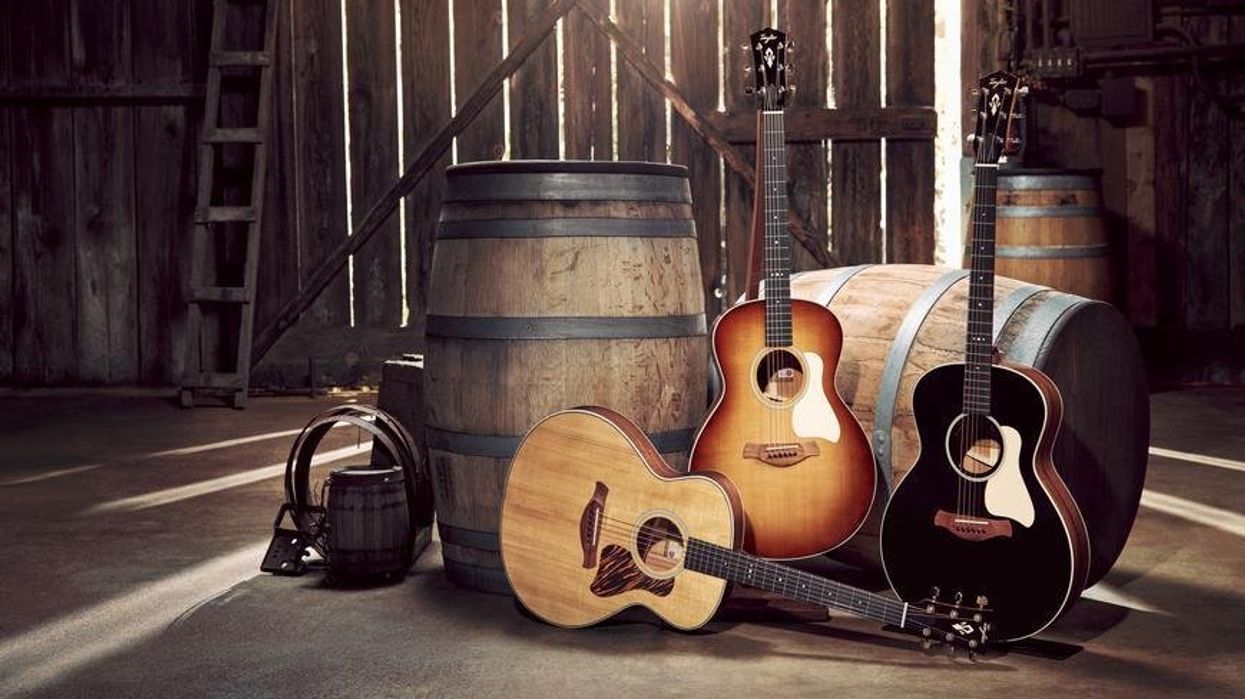
Today, Taylor Guitars, the leading global builder of premium acoustic guitars, announced the expansion of its Gold Label Collection with three new models: the Gold Label 514e, Gold Label 714e, and Gold Label 817e. The launch follows the success of the Gold Label Collection 814e introduction in January and Grand Pacific models in June, reflecting strong market demand for the heritage-inspired line. The new models bring the Gold Label collection to 18 total models, offering players more options within Taylor's premium acoustic range that delivers a rounder, warmer, more robust flavor of acoustic tone. The models are available at authorized Taylor dealers worldwide and on taylorguitars.com.
Three Defining Innovations
The Gold Label Collection showcases three key innovations that set it apart from traditional Taylor offerings. Fanned V-Class® Bracing features a fan-like arrangement of braces in the soundboard's lower bout, delivering on the original promise of a flexible voicing platform that gives these models a warmer, more resonant, more powerful sound. The patented Action Control Neck® features a long-tenon neck joint that extends deeper into the body to boost low-end resonance while maintaining a slim, fast-playing profile. It also enables quick, precise string height adjustments with a turn of a bolt through the soundhole without the need to remove the neck or strings. Completing the package, the collection's Heritage-Inspired Aesthetics draw from old banjos and mandolins, early Taylor designs, and Powers' pre-Taylor archtop work, featuring his modified headstock shape with an angled back cut and a script-style Taylor logo inlay and unique pickguard shape.
Gold Label 514e Super Auditorium
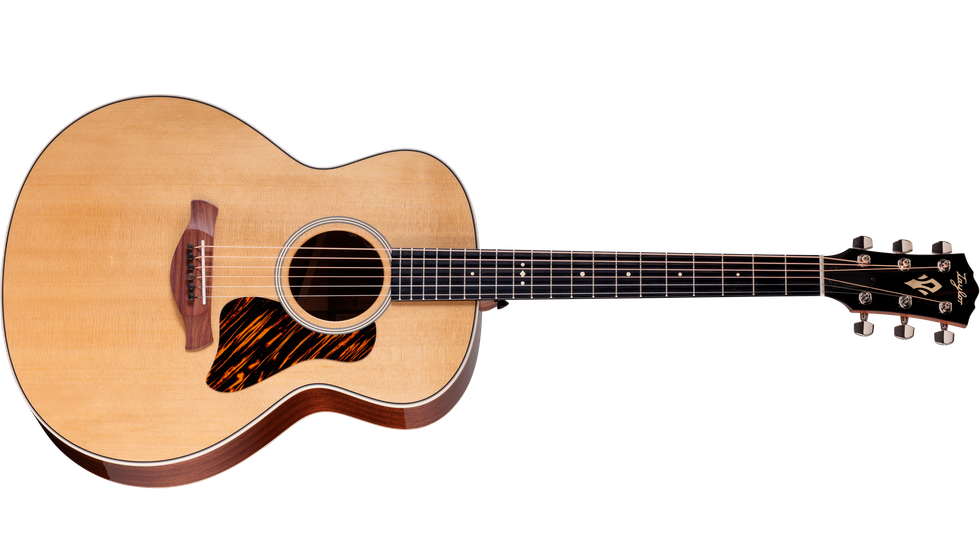
Solid mahogany back and sides paired with torrefied Sitka spruce deliver a rich, earthy midrange character with woody response and powerful projection. Available in natural, blacktop or golden-brown sunburst finishes with cream-colored "Crest" inlays and cream body binding.
Gold Label 714e Super Auditorium
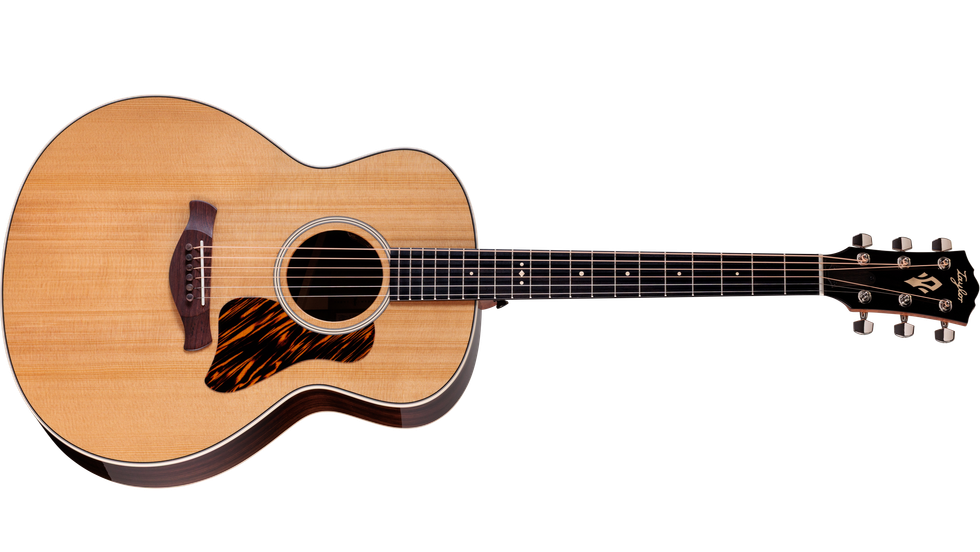
Indian rosewood and torrefied Sitka spruce showcase rosewood's characteristic deep lows, rich trebles and blooming overtones with impressive dynamic range. The model features understated appointments that channel the collection's workhorse spirit.
Gold Label 817e Grand Pacific
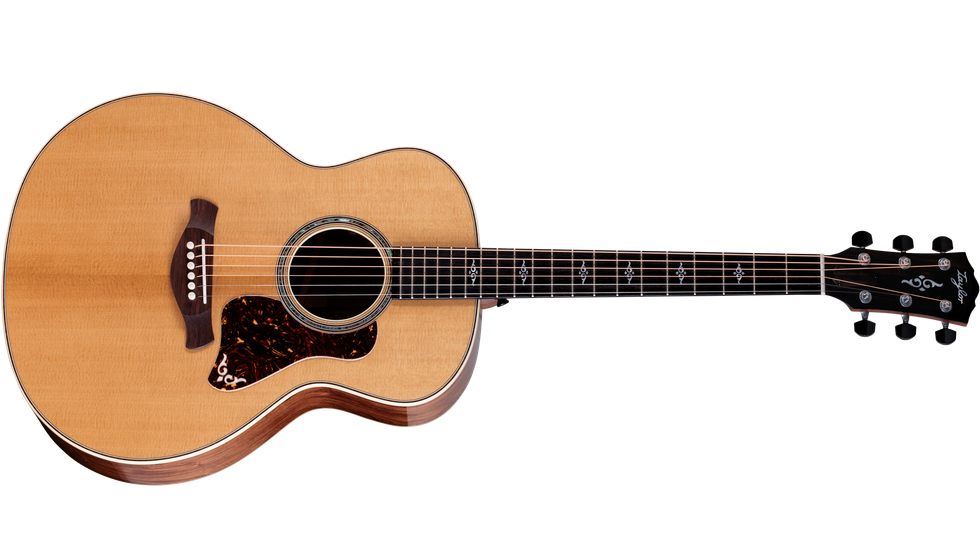
Honduran rosewood and torrefied Sitka spruce offer harmonically rich tone with inspiring old-school sonic character. The Grand Pacific body shape, with 3/8-inch of extra depth at the soundhole, provides greater volume, warmth and low-end expansiveness that are ideal for robust strumming and dynamic flatpicking.
Stage and Studio Acclaim
The Gold Label Collection has earned praise from both recording professionals and touring crews for its distinctive sound and innovative features. Producer/engineer Ben Moore, who has recorded guitar players for over 30 years, noted the collection's unique sonic character: "When a client opened the case and I saw a Taylor, I already had a sonic shape in mind before they strummed a single chord. The Gold Label guitars sound nothing like those guitars. The harmonic complexity
and midrange voice are nothing like any Taylor I have heard before. Microphones LOVE them.”
The Gold Label’s practical innovations have also won over touring professionals. "Having the 517e out on the road was such a treat,” said Matt Yankovich, Guitar Tech for Balance and Composure, and Mom Jeans. “The Action Control Neck is a touring guitar tech's dream come true — finally having the ability to quickly make action adjustments on the fly to keep things comfortable without needing to sand down saddles is an absolute game changer in the world of acoustic guitars."
The Gold Label 514e, 714e and 817e models are available now at authorized Taylor dealers worldwide starting at $2,599. All models include Taylor's Deluxe Hardshell Case and feature LR Baggs Element VTC electronics. For more information about the Gold Label Collection, visit TaylorGuitars.com.
EVH Launches 5150 Iconic Series 15W EL34 Head
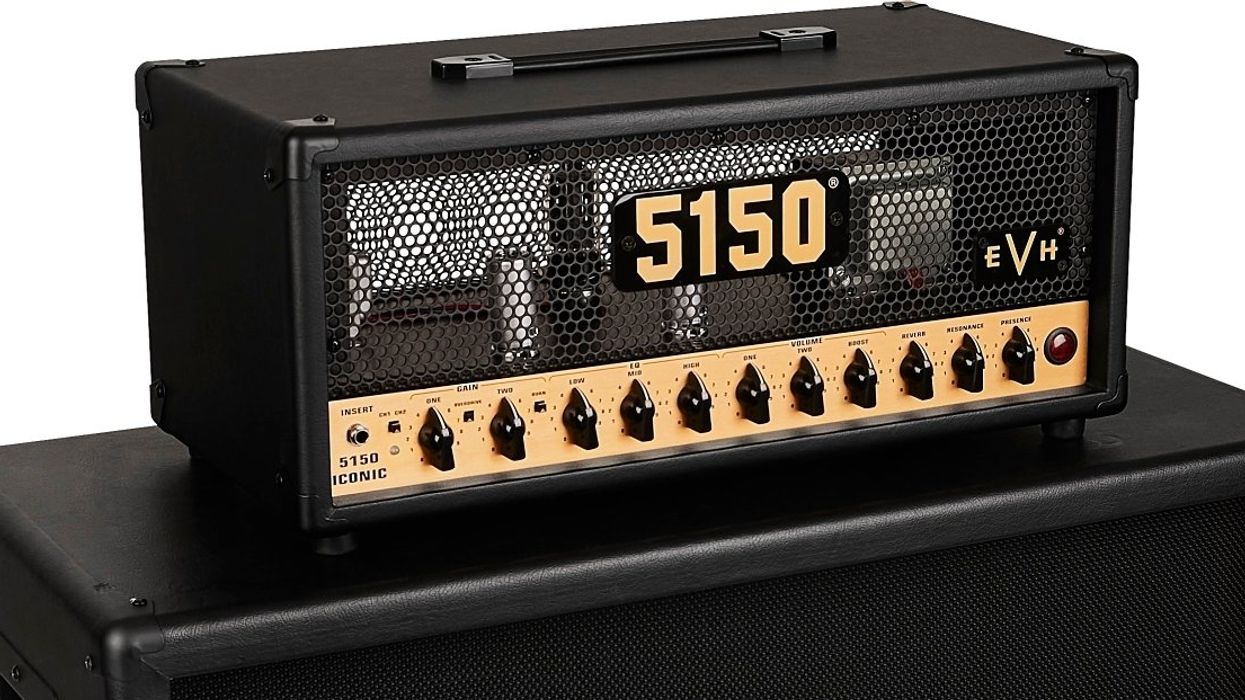
The EVH® 5150® Iconic® Series satisfies the needs of gigging and recording guitarists craving that powerful EVH tube tone, but at a more affordable price. Evolving from the revered EVH 5150III® amplifiers, the Iconic Series delivers the signature sound and growling gain that Eddie Van Halen made famous throughout his groundbreaking career.
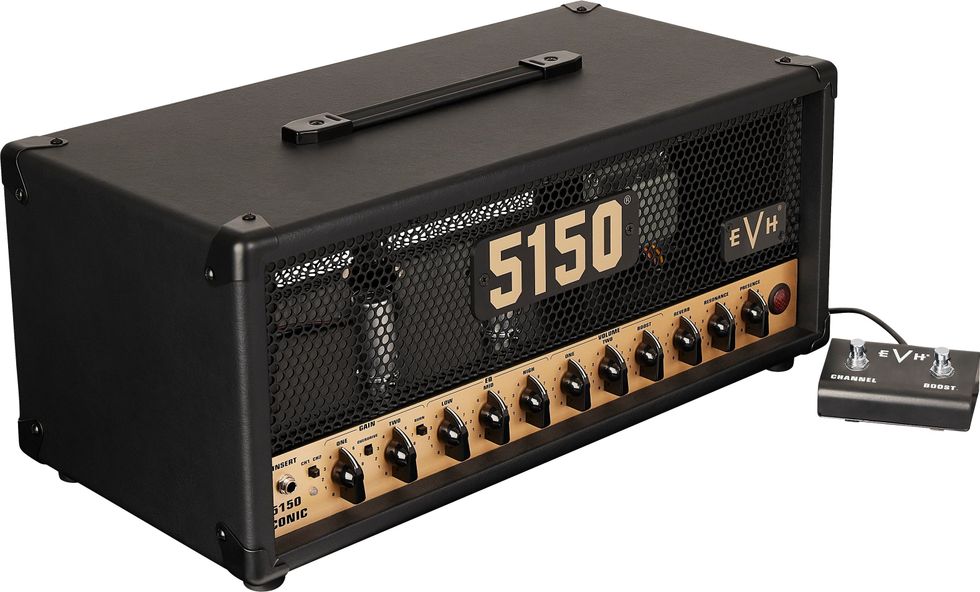
Designed by renowned amp engineer, James Brown, the 5150® Iconic® Series 15-watt Head is powered by one EL34 power tube and voiced by a complex, multi-stage hybrid preamp section anchored by a duet of ECC83 tubes providing all the fire power the modern guitarist needs.
Punching above its weight, this head features two channels with an extra voicing on each for even more versatility. The Green channel boasts an overdrive button to run from clean tones to increased gain, while the Red channel’s burn button adds fiery crunch that’s ideal for blistering leads. Each channel houses its own gain and volume controls, allowing for level-matching the volume when switching between the clean and high gain channels. The Boost control allows you to add another 10Db of foot-switchable volume to your tone - perfect for ensuring your solos cut through the mix.The control panel also includes shared EQ (Low, Mid and High), global resonance and presence knobs to adjust the low- and high-end aspects of your tone, and a global reverb to add the perfect amount of bounce and decay for any room.
Other features include a two-button footswitch, effects loop, dual parallel speaker output jacks, ¼ power switch to reduce wattage - allowing you to crank the amp and still preserve tone but without destroying your neighbor’s solitude, and a speaker-emulated DI XLR with power amp mute for accurate all-tube EVH tone for recording direct or using through any PA system. Sporting sophisticated and distinctive EVH style, the 5150 Iconic Series 15-watt Head is wrapped in Black textured vinyl with a brushed gold anodized aluminum front panel and black steel grille featuring gold and black 5150 and EVH logo badges. This This tube head is finished off with a brushed gold anodized aluminum control panel, vintage-style chicken-head knobs and molded black plastic top handle.
Learn more here.
D’Addario Introduces the Premium String Change Mat
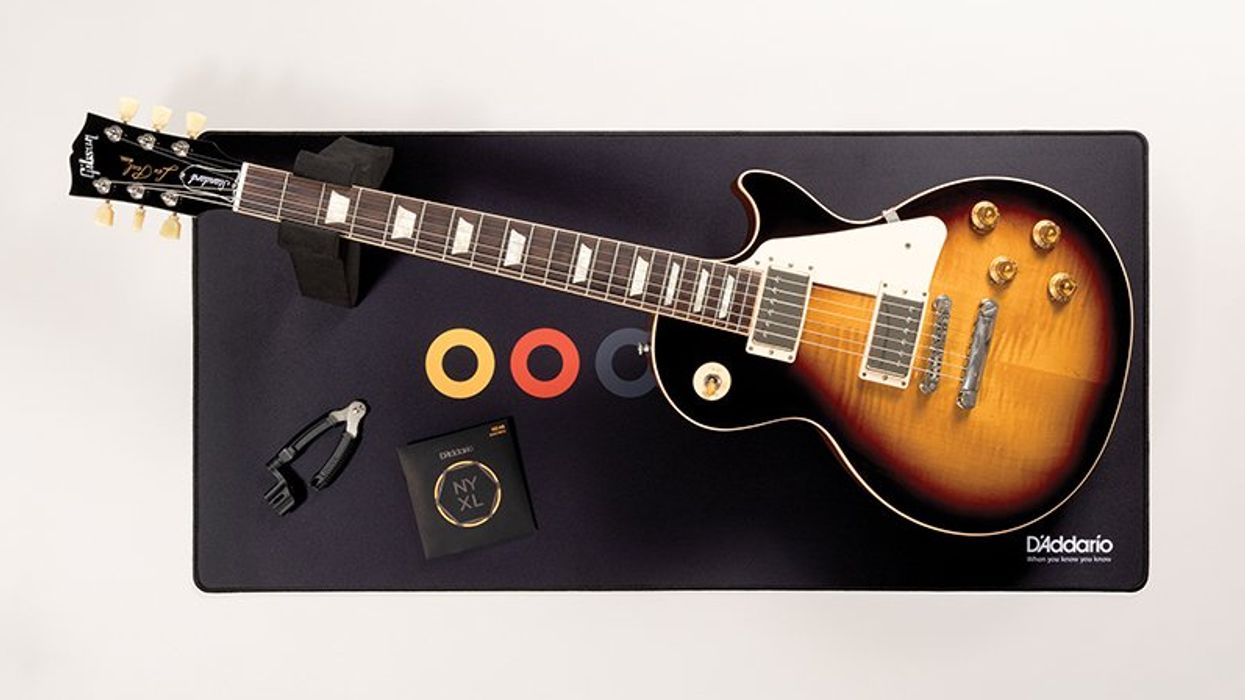
D’Addario announces the Premium String Change Mat, a must-have for luthiers, techs, and players who need reliable, finish-safe support during string changes and instrument maintenance.
Reliable Support for Every Restring & Repair
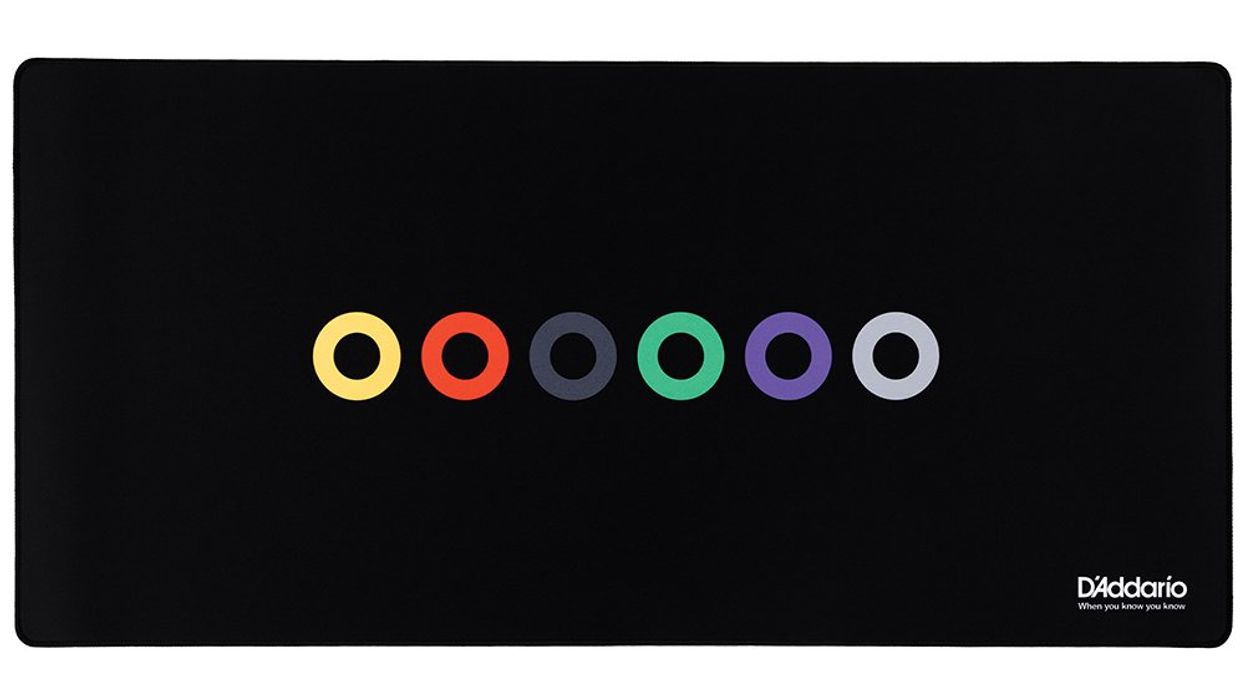
Designed with D’Addario’s iconic ball-end logo, the oversized mat measures 37.4” x 17.7”. On the surface is a soft, smooth fabric surface that’s safe for all finishes. Meanwhile, the underside is made of anti-slip rubber to ensure stability while you work, and the stitched edges improve long-term durability. Whether you’re performing an at-home tune up or prepping gear on the road, this mat keeps your instrument steady, protected, and scratch-free while you care for it.
A Must-Have Tool
"We want you to enjoy changing your strings. This mat was designed to be comfortable and functional, transforming your string change from a chore to a retreat," said D'Addario's Business Development Manager, Danny Mele.
Features:
- Soft, Smooth Fabric Surface
- Anti-Slip Rubber Underside
- Stitched Edge
- Ethically sourced and packaged with zero plastic
- D’Addario’s iconic ball-end logo
Product Info:
- Street Price: $29.99
- Available now at daddario.com and through participating retailers and distributors
- More Info: https://ddar.io/pscm-pr
Jackson Brings Iconic Rhoads to American Series Lineup

Today, Jackson introduces a legendary shape to its prestigious American Series lineup: The American Series Rhoads RR24 and RR24 HT. Born from a 1980 collaboration between metal icon, Randy Rhoads, and founder, Grover Jackson, this distinctive angular shaped design was built for the ultimate shredding performance. Featuring USA-made Seymour Duncan® JB and ‘59 humbuckers pickups, a reverse 6 in-line headstock and the signature offset Rhoads alder body, the American Series Rhoads delivers the bold, brutal tone that metal enthusiasts demand.
Meticulously crafted in Jackson’s Corona, California factory, the American Series Rhoads is built to devastating perfection through premium materials and components including alder bodies with three-piece neck through construction and 12-16" compound radius ebony fingerboard with jumbo stainless steel frets. This launch expands the American Series beyond its current Soloist™ and Virtuoso™ models, reinforcing Jackson's commitment to supporting heavy music artists with uncompromising quality instruments. Rhoads' pursuit of precise, architectural solos helped define the template for metal guitar playing that continues to influence generations of players. Embodying the authentic Rhoads DNA, this American-made guitar is engineered for shredding perfection.

“The American Series Rhoads was created to bring the legendary shape that metal guitarists have coveted for decades to a new generation,” said Jon Romanowski, VP of Product, Jackson. “Built in the U.S., this premium guitar is engineered for players who demand uncompromising metal tone and performance.”
The American Series Rhoads is available in two models: the RR24 and RR24 HT, with the bridge being the main difference between them. The RR24 HT features a Hipshot hardtail bridge made for rock-solid tuning stability and ease of use for string changes or for drop tunings on the fly. This guitar is available in Satin Black and Snow White. The RR24 takes a different approach with its recessed 1500 Series Floyd Rose® double-locking tremolo system for dive bombs, squeals and flutters while staying in tune through brutal playing. This tremolo-equipped model is available in Satin Black, Matte Army Drab and Snow White.
To introduce the legendary American Rhoads series, Jackson has partnered with metal virtuosos and signature artists, Brandon Ellis and Jeff Loomis. Both Ellis and Loomis continue to leave an indelible mark on the metal genre through their revolutionary playing styles and technical mastery. The Rhoads shape continues to empower guitarists to push the boundaries of heavy music, delivering crushing tone and uncompromising performance. This collaboration reinforces Jackson's commitment to supporting the artists who define modern metal while honoring the legacy of one of guitar's most influential innovators.
“This axe embodies everything the Jackson name has always stood for to me,” said Brandon Ellis. “It's built for metal and speed, and comes 100% tour-worthy right off of the shelf, with bulletproof American construction, high quality specs and hardware and contemporary upgrades. The easily accessible spokewheel adjusted truss rod, push-in style tremolo bar, stainless steel Floyd Rose upgrades, glow in the dark side dots and locking tuners are all huge quality of life improvements for performing musicians like myself. I have the matte finished olive drab version which both feels amazing in my hands and looks killer on anybody who wields this classic, sharp-angled, metal beast of a guitar!”
“The American Series Rhoads is an amazing metal masterpiece!” said Jeff Loomis. “Aggressive looks with killer playability all over the neck, this guitar really stands out. Partnering with Jackson again to showcase this guitar with Brandon Ellis was a total blast and unforgettable experience.”
Watch these legends unleash their metal prowess: Presenting the American Series Rhoads Feat. Jeff Loomis & Brandon Ellis | Jackson Guitars. High-resolution product and lifestyle images of the American Series Rhoads RR24 can be found HERE. Full product descriptions and specifications of the American Series Rhoads RR24 can be found HERE.
AMERICAN SERIES RHOADS RR24
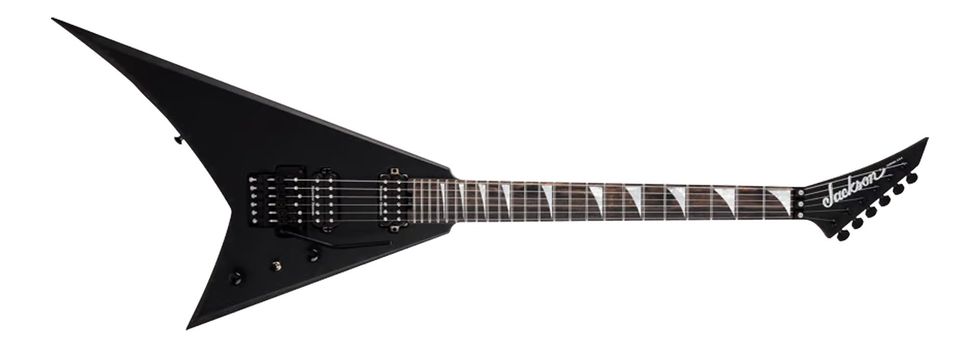
($2,849.99 – $2,899.99 USD, £2,249 GBP, €2,649 EUR, $5,149 – $5,249 AUD, ¥528,000 JPY)
The RR24’s offset Rhoads alder body turns heads with its sleek, weapon-like contours while providing resonant, lively tone. Its neck-through-body three-piece maple neck with graphite reinforcement delivers supreme stability and sustain. 24 Jumbo stainless-steel frets top the 12”-16” compound radius ebony fingerboard allowing effortless bending across the entire fretboard. For tone that’s tight yet expressive, we’ve equipped the RR24 with Seymour Duncan® JB and ‘59 humbuckers. These USA-made pickups roar with thick distortion when you dig in, cleaning up nicely for singing leads. The recessed 1500 Series Floyd Rose® double-locking tremolo system lets you execute dive bombs, squeals and flutters while staying in tune through heavy abuse.
AMERICAN SERIES RHOADS RR24 HT
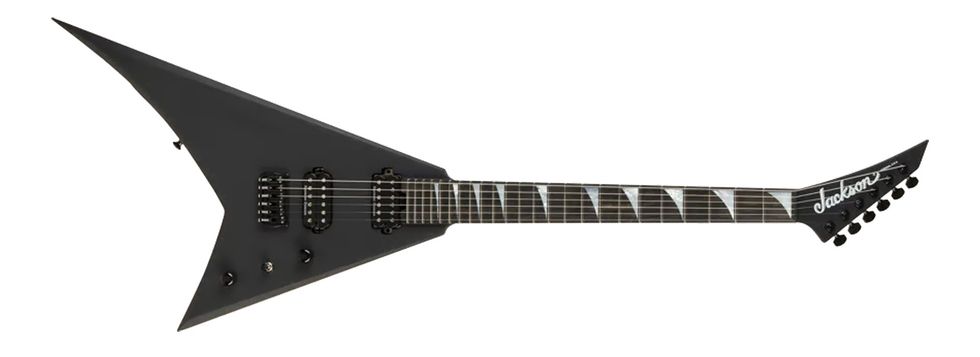
($2,729.99 – $2,779.99 USD, £2,199 GBP, €2,599 EUR, $4,949 – $5,049 AUD, ¥517,000 JPY).
The RR24’s offset Rhoads alder body turns heads with its sleek, weapon-like contours while providing resonant, lively tone. Its neck-through-body three-piece maple neck with graphite reinforcement delivers supreme stability and sustain. 24 Jumbo stainless-steel frets top the 12”-16” compound radius ebony fingerboard allowing effortless bending across the entire fretboard. For tone that’s tight yet expressive, we’ve equipped the RR24 HT with Seymour Duncan® JB and ‘59 humbuckers. These USA-made pickups roar with thick distortion when you dig in, cleaning up nicely for singing leads. The Hipshot® hardtail bridge makes for rock-solid tuning stability, and ease of use for string changes or for drop tunings “on the fly”.
“We said, ‘F**k England, let’s move to America’”: Peter Frampton reveals that he left the UK because Humble Pie hated having screaming girls at their gigs

Every band wants their music to be heard – but what if the attention gets a bit too intense? When Humble Pie’s 1969 single, Natural Born Bugie, peaked at number 4 in the UK charts, the rockers quickly grew tired of the screaming fans that began to attend their gigs.
In a new interview with Uncut, vocalist and lead guitarist Peter Frampton admits that he particularly hated the fangirls that Natural Born Bugie lured in. “It was a hit, so of course we had to play it on Top Of The Pops,” he recalls. “Steve Marriott [vocalist] really didn’t want to do it. He wasn’t thrilled. Of course, the first time we did it, as soon as we did our next gig we got screamed at.”
Prior to being in Humble Pie, Frampton and the late Marriott were keen to shake off a “popstar” image. Record labels weren’t treating them seriously, and Humble Pie was there way of gaining a bit of respect – however, when exposed to a mass of female fans on Top Of The Pops, the pair of singers were yet again treated like “pin-up” boys next door.
“I looked at Steve, Steve looked at me and we said, ‘They’re screaming?’” Frampton says. “That’s why we had formed Humble Pie, to get away from that! So that’s when we said, ‘Fuck England, let’s move to America.’”
But it wasn’t just the singers who noticed the screaming. Drummer and keyboardist Jerry Shirley chips in, adding: “We wanted to get away from the screamers. We even started our set with an acoustic section, so Peter was sat there with an acoustic guitar and all these girls were screaming at him. It was not normal.”
Frampton goes on to admit that Marriott hated the response so much that he wanted to cut Natural Born Bugie from the set entirely. “Steve didn’t want to play the single at concerts,” he explains. And, for a short while, the band would indeed leave the track out of their set.
However, Humble Pie have since learned to love the single once again. The track has even been remastered for a shiny re-release of the band’s 1969 debut, As Safe As Yesterday Is.
The remastering of As Safe As Yesterday is out now.
The post “We said, ‘F**k England, let’s move to America’”: Peter Frampton reveals that he left the UK because Humble Pie hated having screaming girls at their gigs appeared first on Guitar.com | All Things Guitar.
The iconic Rhoads is “returning home to California” as Jackson announces its addition to its American Series

Jackson’s iconic Rhoads blueprint – first conceived by both Ozzy Osbourne guitarist and legend Randy Rhoads and Jackson founder Grover Jackson – is “returning home to California”, as it makes its entry into the brand’s American Series lineup.
Two new models – the American Series Rhoads RR24 and RR24 HT – are built in Jackson’s Corona, California factory, which also produces Jackson’s most high-end instruments.
Delivering “uncompromising quality and performance”, the American Series Rhoads features USA-made Seymour Duncan JB and ‘59 humbuckers for a “tight yet expressive” tone, a reverse six-in-line headstock, resonant alder body with “weapon-like” contours, and a 12”-16” compound radius ebony fingerboard with 24 jumbo stainless steel frets.
Specs are, for the most part, identical on each model, except – for the keen-eyed amongst you paying attention to naming conventions, the RR24 HT sports a Hipshot hardtail bridge “for rock-solid tuning stability”, while the RR24 is equipped with a recessed 1500 Series Floyd Rose double-locking tremolo system – perfect for those huge divebombs.
 Credit: Jackson
Credit: Jackson
The addition of the RR24 and RR24 HT expands Jackson’s American Series beyond its existing Soloist and Virtuoso models.
“The American Series Rhoads was created to bring the legendary shape that metal guitarists have coveted for decades to a new generation,” says Jon Romanowski, VP of Product, Jackson.
“Built in the US, this premium guitar is engineered for players who demand uncompromising metal tone and performance.”
 Credit: Jackson
Credit: Jackson
The brand adds: “Rhoads’ pursuit of precise, architectural solos helped define the template for metal guitar playing that continues to influence generations of players. Embodying the authentic Rhoads DNA, this American-made guitar is engineered for shredding perfection.”
Granted the honour of being the first guitarists to take the new American Series Rhoads for a spin are metal virtuosos and Jackson artists Brandon Ellis and Jeff Loomis, formerly of the Black Dahlia Murder and Arch Enemy, respectively. Watch them tear it up in the video below:
“This axe embodies everything the Jackson name has always stood for to me,” says Brandon Ellis. “It’s built for metal and speed, and comes 100% tour-worthy right off of the shelf, with bulletproof American construction, high quality specs and hardware and contemporary upgrades.
“The easily accessible spokewheel adjusted truss rod, push-in style tremolo bar, stainless steel Floyd Rose upgrades, glow in the dark side dots and locking tuners are all huge quality of life improvements for performing musicians like myself.”
“The American Series Rhoads is an amazing metal masterpiece!” adds Jeff Loomis. “Aggressive looks with killer playability all over the neck, this guitar really stands out. Partnering with Jackson again to showcase this guitar with Brandon Ellis was a total blast and unforgettable experience.”
The RR24 is available in Satin Black, Matte Army Drab and Snow White, while the RR24 HT comes in Satin Black and Snow White.
The RR24 and RR24 HT are priced at £2,249 and £2,199, respectively.
For more info, head to Jackson.
The post The iconic Rhoads is “returning home to California” as Jackson announces its addition to its American Series appeared first on Guitar.com | All Things Guitar.
Deftones' Stephen Carpenter Rig Rundown
California metal giants Deftones returned this year with Private Music, their first album in five years. In support of it, they ripped across North America on a string of headline shows and support slots with System of a Down.
We linked with Deftones guitarist Steph Carpenter for a Rig Rundown back in 2013, but a lot has changed since then (and as Carpenter reveals in this new interview, he basically disowns that 2013 rig). Back in August, PG’s Chris Kies caught up with Carpenter again ahead of the band’s gig in Milwaukee, Wisconsin, where the guitarist gave us an all-access walkthrough of his current road rig.
Brought to you by D’Addario
Blue Battle-Axe
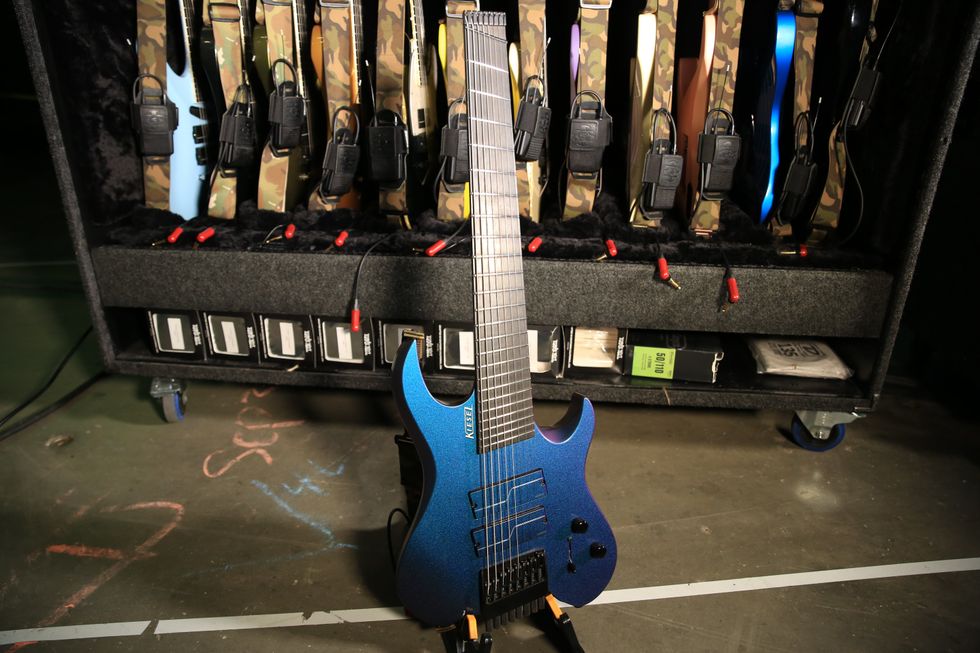
This headless, color-shifting Kiesel Vader 8 was the first Kiesel that Carpenter got his hands on.
Kiesel Kavalcade
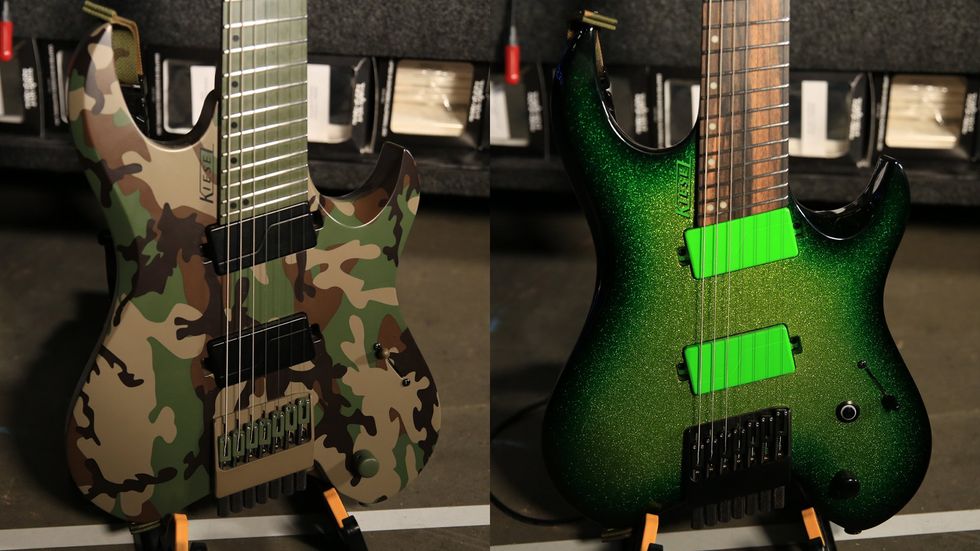
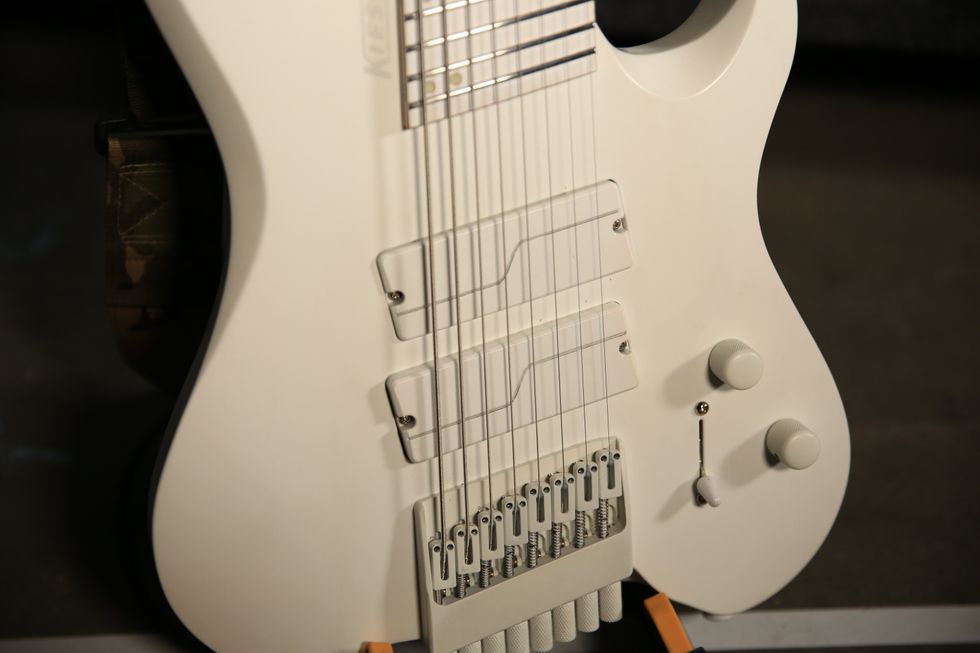
Carpenter requested Vader models in all-black, all-white, and goldtop finishes, then Jeff Kiesel himself surprised Carpenter with the remainder, including the camo and green sparkle models shown here. Carpenter will choose which guitar to use based on how he’s feeling each evening. To record Private Music, he switched between his trusty ESPs and these new favorites.
Steph’s Selections
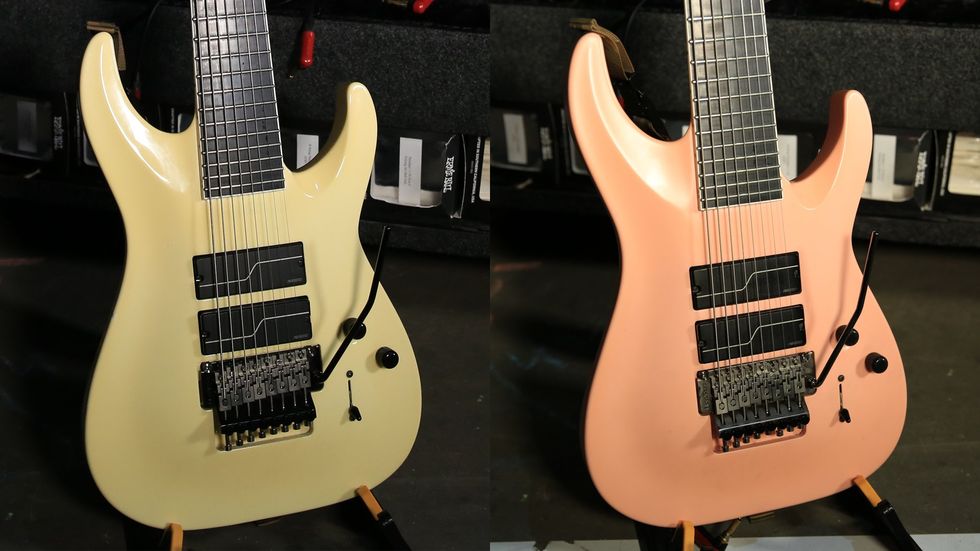
One of Carpenter’s two guitar vaults is full of his current favorite ESPs. Of those, this glow-in-the-dark version, along with the pink-finish model, is his top pick. Curious about his pickup configuration? It’s got nothing to do with sound; it’s purely based on how guitarists like Vivian Campbell and Adrian Vandenberg set up their guitars. Carpenter loved the look, so he copied it.
Back to Bogners
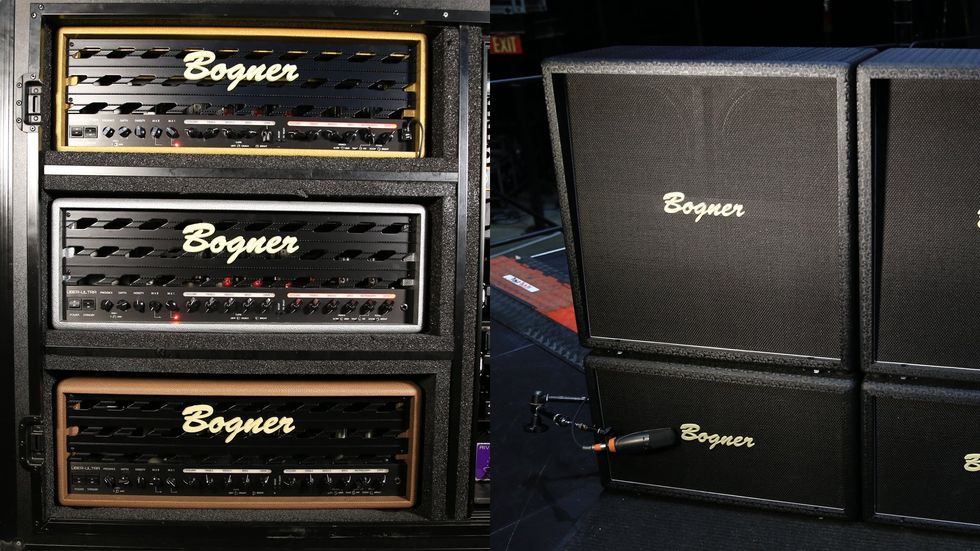
Carpenter says he’s had “too many fails” relying on a completely digital rig, so these days he rolls with a hybrid setup designed by his tech, Greg Dubinovskiy, and Dave Friedman, the latter of whom built the rig.
It’s based around these KT88-loaded Bogner Uberschall Uber-Ultra heads, which are wired to two Bogner 2x12 UberKabs (with one Celestion V-30 and one G12T-75 each) and two Bogner 4x12 UberKabs (with two V-30s and two G12T-75s in an X pattern). A Shure Nexus 57 and Shure KSM32 are used to capture the amp sound.
Rack Rundown
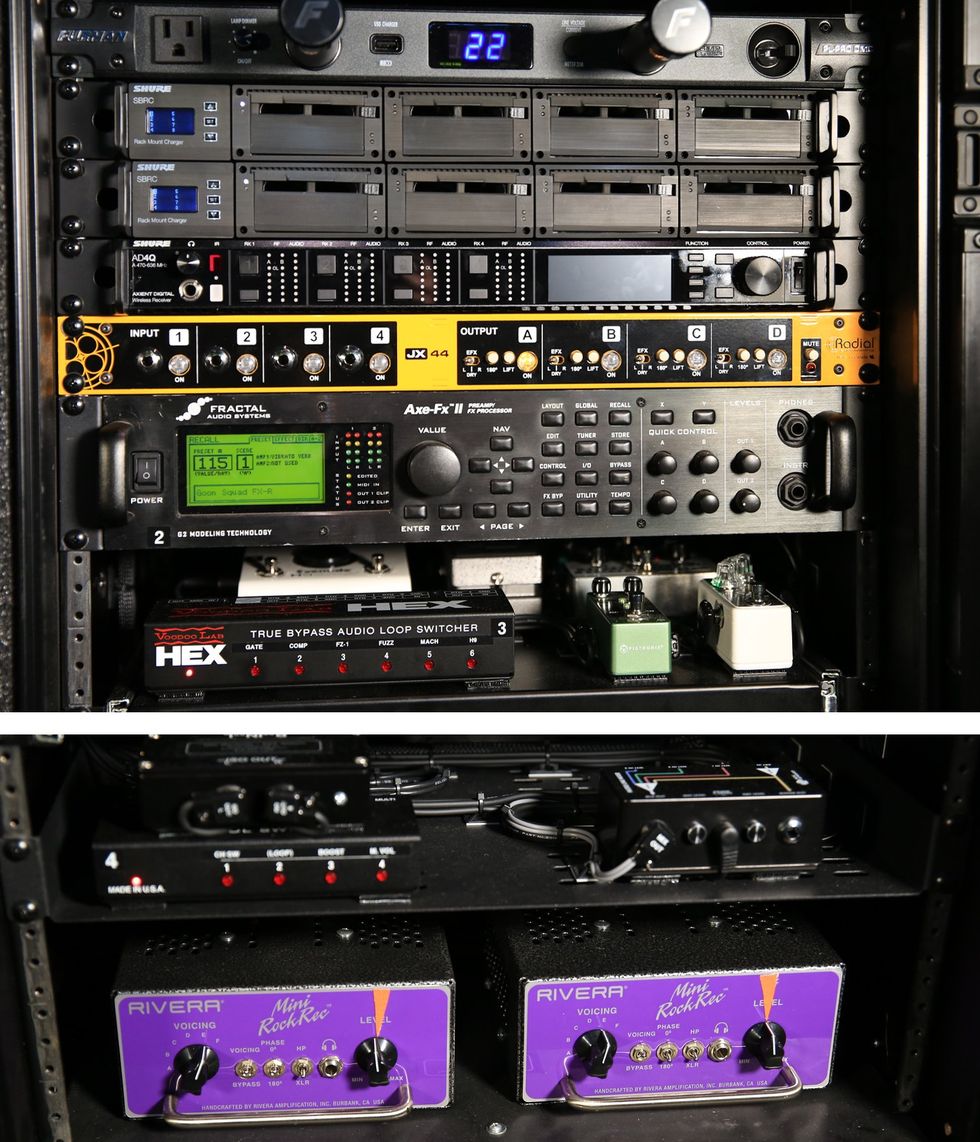
Beside the Bogner’s, another rack houses a Shure AD4Q, Radial JX 44, and a Fractal Axe-Fx II. (Carpenter has no desire to upgrade to the latest model.) Lower down, there’s a pair of Rivera Mini RockRecs.
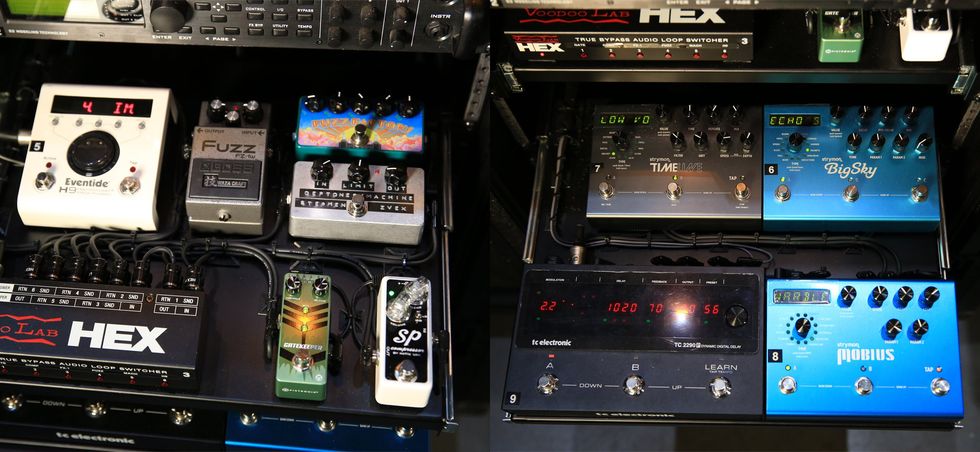
Most of Carpenter’s pedals are shelved below these units, including an Eventide H9, Boss FZ-1, ZVEX Fuzz Factory, custom ZVEX Machine, , Pigtronix Gatekeeper, Xotic SP Compressor, Strymon Mobius, Strymon BigSky, Strymon Timeline, and TC Electronic TC 2290. A Voodoo Lab Hex powers the pedal party.
Steph Carpenter’s Pedalboard
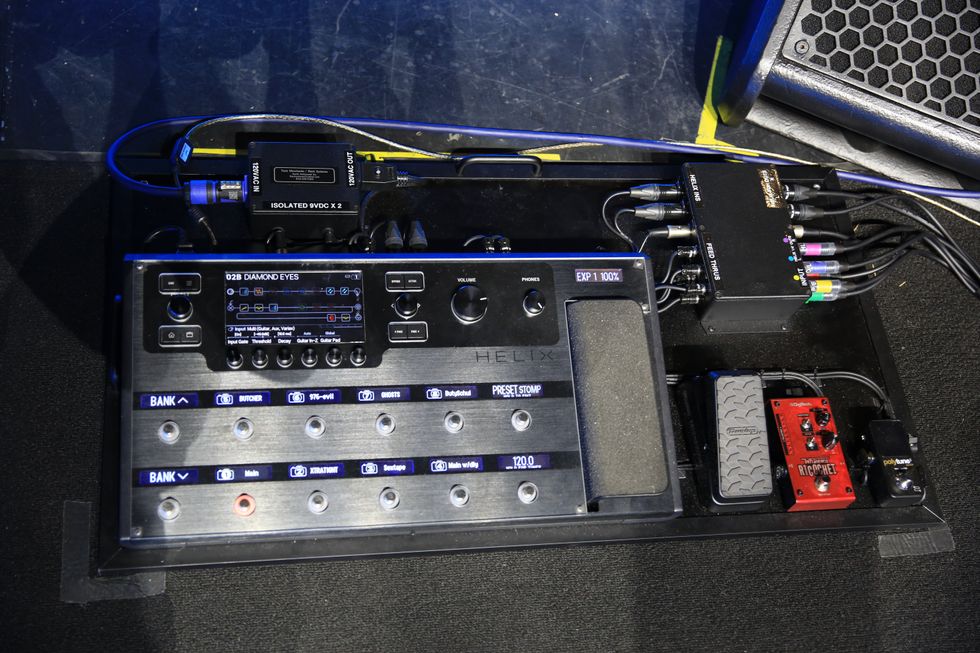
Carpenter’s Line 6 Helix unit is the brain of his setup, and handles all switching. Also on hand are a DigiTech Whammy Ricochet, a Dunlop Volume (X) Mini pedal, and a TC Electronic PolyTune 3 Noir.
“He took the living influence of Bob Dylan, and he turned that into a dragon in his hands”: Vernon Reid on why Jimi Hendrix is unsurpassed as a guitar hero
![[L-R] Jimi Hendrix and Bob Dylan](https://guitar.com/wp-content/uploads/2025/09/Jimi-Hendrix-Bob-Dylan@2000x1500.jpg)
Living Colour’s Vernon Reid has revealed his ultimate guitar hero – and, unsurprisingly, it’s Jimi Hendrix.
In a new interview with Classic Rock, Reid asserts that nobody can surpass the genius of Hendrix. “There are many other heroic guitarists before him, but he went against all the odds and expectations,” he explains. “He took the living influence of Bob Dylan, and he turned that into a dragon in his hands.”
- READ MORE: “Did you guys make a mistake?”: MGK admits he’s baffled as to why Bob Dylan is a fan of his
Reid picks out Hendrix’s red-hot performance in 1967 at Monterey Festival as his case in point. The show saw him dousing a 1965 Fender Stratocaster in lighter fuel, with the blaze leading to Hendrix burning both his hands and being sent to hospital following the performance.
“When he burnt his guitar at Monterey, it was a crypto critique of capitalism,” Reid reflects. “What a guitar meant for everyone, he changed it. And he did it with incredible songs.”
It’s not the first time Reid has voiced his respect for Hendrix. Last November, Reid picked out Manic Depression from Hendrix and The Experience’s 1967 debut, Are You Experienced, as one example of Hendrix’s “incredible” catalogue.
“Manic Depression doesn’t get nearly enough respect for what a groundbreaking song it STILL is,” he wrote on X. “It describes struggles with mental illness directly, not via metaphor. It was unprecedented in rock history. It laid a roadmap for Pink Floyd’s Dark Side Of The Moon to expand upon.”
He followed the post up with another shout out to another Are You Experienced cut, The Wind Cries Mary. “[It is one of] the greatest meditations on the nature of grief and loss ever written,” he reflected.
Reid’s upcoming record, Hoodoo Telemetry, is set to drop next month. The record promises to be an “eclectic” journey through his palette, with funk-infused The Haunting and the floating, gentle soulful touch of Beautiful Bastard serving as our first taste of what is yet to come.
Hoodoo Telemetry is due to drop on 3 October.
The post “He took the living influence of Bob Dylan, and he turned that into a dragon in his hands”: Vernon Reid on why Jimi Hendrix is unsurpassed as a guitar hero appeared first on Guitar.com | All Things Guitar.
“It’s quite a nice change to occasionally not be in a band with my brothers”: Greta Van Fleet’s Jake Kiszka on why he’s embarking on side project band Mirador

Last May, Greta Van Fleet’s Jake Kiszka announced his new side-project, Mirador. While the project allows Jake to expand upon his bluesy folk rock palette, it’s also his first opportunity to write with people that aren’t his brothers – and it’s been a breath of fresh air.
Despite cherishing the musical bond he shares with his Greta Van Fleet bandmates, brothers Josh and Sam Kiszka, Jake admits it’s an “exhilarating change” to collaborate with different people – particularly Ida Mae’s Chris Turpin. “I’d always written music with my brothers so there are all sorts of particular complexities in that, but I’ve never worked like this before,” he explains to Kerrang!. “And you know what? Chris can really write.”
“He’s the full package; he sings great, is a brilliant lyricist and a genius guitar player,” he continues. “Locking in, one-to-one, to write and record with an individual – I’d never done that before. There are many different parameters with Greta, so to do this with Chris was an exhilarating change.”
Alongside Turpin, the line-up is rounded off by drummer Mikey Sorbello and Nick Pini on bass and keys. Together, the foursome are churning out blues rock and infusing folk with an edge of rock ‘n’ roll. “It’s something we can come back to outside of our other bands, not just because we love it but because we genuinely want to grow,” Jake explains.
“It’s quite a nice change to occasionally not be in a band with my brothers – it’s different to be in a band of people that are just friends. Some people you choose to be with; others you are just stuck with… No, I’m kidding!”
That being said, Mirador have already been given a huge platform supporting Greta Van Fleet on a recent tour. So, in a way, Jake’s brothers have still been a massive help by believing in his new project. “We’d be on as the first band of three in an arena that might be 12,000-capacity,” Jake says. “The response was so overwhelming that by set two they seemed to be singing back 75 per cent of the songs. By our third show it was like they knew all the songs. It was unbelievable.”
This Friday, Mirador’s debut is set to drop. Fortune’s Fate and Feels Like Gold serve as the first taste of what the project has to offer – and it’s certainly got plenty of intricate licks to dig your teeth into. “It’s a positive time to be doing this,” Jake says. “Hundreds of thousands of young fans are pouring into rock’n’roll shows now. It’s a wonderful thing for us to be a part of this great time in history!”
Mirador’s self-titled debut is out 19 September.
The post “It’s quite a nice change to occasionally not be in a band with my brothers”: Greta Van Fleet’s Jake Kiszka on why he’s embarking on side project band Mirador appeared first on Guitar.com | All Things Guitar.
Multi-effects signal chains explained – everything you need to play and record direct

It wasn’t that long ago that home recording meant floors covered in effects pedals with a patchwork of cables leading from the bedroom into bathrooms and other nooks and crannies; turning our homes into impromptu recording studios and agonising over our cabinet mic placement.
That approach to home recording is by no means dead, but with the continued development of digital amp modellers and amp sim pedals, we no longer have to turn our homes upside down when we want to noodle and record with high-quality sounds.
While the digital package is more compact, it still comes with a learning curve. In this guide, I’m going to (hopefully) demystify the process of building a digital signal chain, highlighting the tools that are essential for playing and recording guitar at home.
What is a digital signal chain?
When we talk about ‘analogue’ guitar playing, the signal chain refers to the path your audio signal takes from guitar to amplifier and the effects it passes through along the way. There is no ‘right’ way to create a signal chain. My early ignorance on the subject created a Sigur Rós-esque distortion-soaked reverb effect that I adored, so it’s always worth experimenting.
When we talk about a digital signal chain, the principle is fundamentally the same, but rather than it being guitar > effects > amplifier it has multiple permutations such as:
- Guitar > floorboard/rack amp modeller / amp sim pedal > mixer/interface > DAW
- Guitar > floorboard/rack amp modeller > DAW
- Guitar > mixer / interface > audio plugins > DAW
- Guitar > amp sim / rehearsal pedal > FRFR cabinet/headphones
There are pros and cons to each of these permutations, not to mention varying cost implications and requirements for your home setup. In some cases, there’s no need for an audio interface/mixer but we’ll go into that later. Before we dive in, it’s important to establish the following:
What do you want to get out of your home setup?
Depending on where you’re at in your guitar journey and what drew you to the instrument will dictate what you need from a home setup. With that in mind, ask yourself these questions:
- Is the purpose of your home setup to play/practise, record or both?
- How much equipment do you have space for?
- What is your budget?
Now that you’ve asked yourself those questions, let’s look at the individual elements that make up a digital signal chain for playing and recording guitar at home, starting with amp modellers.
Amp modellers and multi-effects units
 Image: Adam Gasson
Image: Adam Gasson
Here at Guitar.com, we’ve reviewed just about every major amp modeller out there. Back in 2021, the amp modeller that really changed the game, Neural DSP’s Quad Cortex, scored a 10/10 from us – and this was before Neural bolstered it with a series of QoL updates, new features and compact sequel. We’ve awarded similar glowing reviews to Kemper’s Profiler Stage, and in more recent years Fender’s Tone Master Pro and Boss’ GX-10.
Amp modellers are your one-stop shop and come equipped with countless digital amp sounds and effects, providing you with hundreds if not thousands of hours experimenting and refining your favourite tone combinations.
Thanks to USB connectivity, they can also function as your audio interface. This makes them an incredibly versatile addition to your home setup; providing you with everything you need to tinker, play, practise, rehearse, perform and record.
However, due to the serious punch these amp modellers pack, you could be looking at prices anywhere between £1,000 – £1,700 if buying brand new. In isolation it’s an eye-watering sum, but when you consider how far that budget would get you when buying amps, effects pedals and an interface; not to mention the amount of flexibility you’d have in tailoring your sound, the space required and the varying reliability of all those bits of equipment, it doesn’t take long before the value of the amp modellers starts to sink in.
It’s worth noting that a lot of these high-end amp modellers have released smaller and more budget-friendly iterations. Neural DSP’s Nano Cortex and Line6’s HX One are great examples of how to distill their predecessor’s DNA into a smaller and cheaper package. Speaking of smaller, cost-effective options, let’s turn our attention to amp sim pedals.
[products ids=”6ru2SrWqvzIT0ep6ZFcAXQ,4cDpuBQfkUhwXUrrSLYElh,B1FoUUSUyi3B2m1GQla65,2WuMky1iFUjk8qhee1PnNm,3Boy4LZm0Kqx95dawNB33c,4RbZPpF01Dh5uNrrEF9v77,6ADpQXMexHjV2MfjsPhuOS”]
Amp and cab sim pedals
 Image: Adam Gasson
Image: Adam Gasson
I don’t know about you, but when I look at something like Kemper’s Profiler Head, I can imagine the sheer quantity of sounds it can produce in that moment. The idea that even a fraction of that power could fit into a stompbox blows my mind, but it’s very much a reality.
In our review of the Walrus Audio Mako Series MKII ACS1, our reviewer said “this is as good as digital amp and cab simulators get”. While Walrus Audio has definitely carved out a niche for itself in terms of quality, they occupy the space with a suite of top-performing competitors. Whether its Universal Audio’s UAFX extensive series of amp and cab simulator pedals, the much-loved Strymon Iridium or the phenomenally good value Boss’ IR-2, there’s oodles of quality to suit a range of budgets.
With a severely reduced footprint and price tag, it should be no surprise that you won’t have quite the same level of tools at your fingertips, though the ACS1 is no slouch on amps to choose from!
That’s not to say you’ll be feeling short-changed as the amount of options under the hood is nothing short of amazing, but do your due diligence in researching what’s out there so you get the perfect fit for your needs.
Amp and cab sim pedals sit at the end of your signal chain, meaning your existing collection of effects pedals will work in perfect harmony and allow you to further tinker in search of that desired sound. The presence of a headphone out is ideal for anyone that can’t practise at full volume and/or isn’t hooking this up to their computer.
While we’re on the topic of hooking this up to computers, it’s worth mentioning that unlike the aforementioned digital amp modellers, these pedals require an audio interface if you’re looking to record while using them. If you’re thinking about relative budgets, unless you’re choosing the premium pedal(s) and audio interface, you’re unlikely to be spending more than the cheapest amp modeller.
[products ids=”5TxYvtVWAuwaawNgLLxEUk,7DvMk7LWI8xoOdCKku5DVE,5x9CmWUuj5rYUXyQdPwgMs,44by41VnpGe0Ly2nkjBzF9,7m74MWIg1x9sZa1pchR9Kn,21N5Q6yXC7vrVGa1stCyR6″]
Rehearsal pedals and FRFR amps
 Image: Adam Gasson
Image: Adam Gasson
This is just a bonus point, but you may have reached this point in the article hoping for something simpler and begun asking:
- What do I do if I don’t want to run an amp sim pedal into my computer, but I also don’t want to practice over headphones?
- Is there a way I can practice with my current pedalboard through headphones without needing an amp sim pedal or amplifier?
If space and portability are important to you, then Headrush’s FRFR Go is hard to beat when it comes to practising without headphones. There are some great alternatives out there like the Fender FR-12, but the FRFR Go leads the pack on price and portability by a mile.
If headphones are the goal, Walrus Audio’s Canvas Rehearsal eliminates the need for an amplifier or amp sim pedal and slots neatly into the end of your pedalboard. You can play your guitar with all your effects in headphones, practise your rhythm with the in-built metronome and time signature functions, and play along to your favourite songs over Bluetooth.
[products ids=”5iHPEBEaoeeOoyJLR7tMCo,6JmLBjNYj9NNAiAoK9JxAs,6SQwAUhdsz1TScKof82nol”]
Audio interfaces and mixers
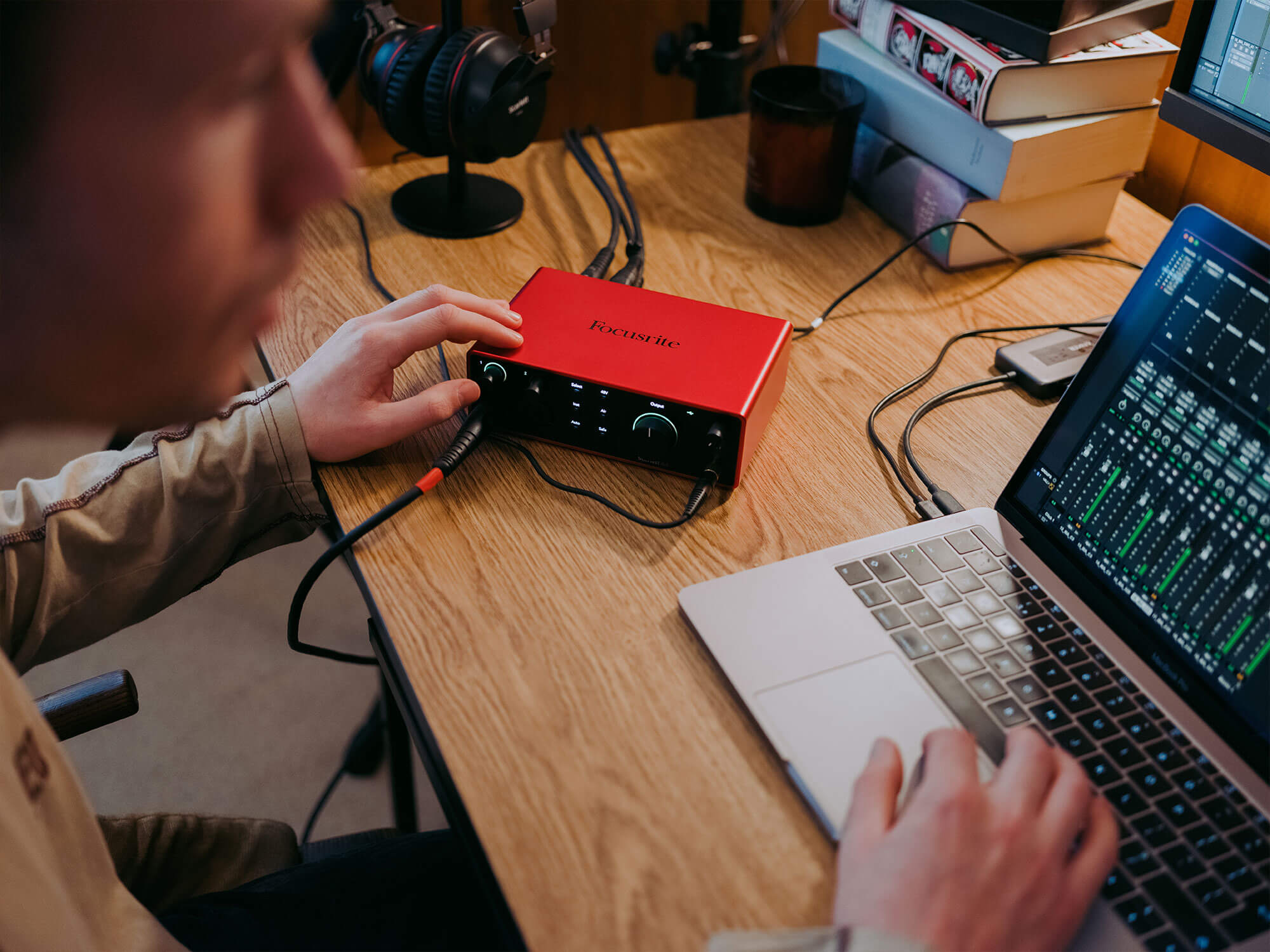
If you’re just looking to play and practise, or even if you’re planning on getting an amp modeller that can double as an audio interface, it may not be necessary to add another item to the shopping list.
If however, you’re after more control on your audio, hoping to record using an amp sim pedal, or you want to record other instruments such as drums, that’s where an audio interface or mixer becomes an integral component of your digital signal chain.
On the simpler, more budget-friendly end of the scale you’ll find the Audient iD4 and Focusrite Scarlett 2i2 4th Gen interfaces; the latter now featuring stereo direct monitoring which is a big deal for those of you wanting to get the most from your stereo amp sims. What you lack in inputs, you gain in ease-of-use and price.
Universal Audio’s Apollo Twin X costs almost £800, but it boasts incredibly low latency for recording – which is invaluable when using amp sims – and comes bundled with some of UA’s stellar hardware plugin emulations, allowing for yet more sonic profiling.
There’s also the PreSonus Quantum HD 2, which can achieve around 3ms latency, comes kitted out with guitar-centric features developed with Fender amongst other pro features and costs 50% less than the Apollo Twin X.
Mixers start at a higher price point due to their increased number of inputs and greater functionality. That being said, Allen & Heath’s ZEDi 10FX, which comes in under £350 and sports some great sounding boutique preamps and the slightly more pricey but fully-featured Tascam Model 12 are well worth investigating if your home recording setup is likely to move beyond guitar alone.
[products ids=”69ARyGFpRDFet9DZNLaqIE,2wL4nkv5Vfp5IkhtS8PZZt,5ggaG7ANt6IHHHzd7QzZAW,3S1JY3asvsRVl5b06L5spq,”]
The post Multi-effects signal chains explained – everything you need to play and record direct appeared first on Guitar.com | All Things Guitar.
Olivia Rodrigo guitar tech on the one thing Gibson keeps getting wrong with its guitar design – as Gibson’s Mat Koehler calls it “disinformation”

Gibson’s been in the guitar making business for well over 100 years, but according to Luis Munoz, guitar tech to pop superstar Olivia Rodrigo, as well as The Smashing Pumpkins and Simple Plan, there’s one thing the brand keeps getting wrong with its guitar design.
In a new video posted on social media, Munoz showcases his process fixing a headstock which had become detached from the neck on a Gibson acoustic guitar, saying the angle of Gibson headstocks in relation to their necks renders them susceptible to breakage.
“Unfortunately, Gibson will never change this,” he writes. “Gibson breaks headstocks so often because of their steep headstock angle, soft mahogany wood, and the thin, weakened area behind the nut (thanks to the truss rod cavity). When they fall, all the force hits that weak spot – so they snap.”
Luis Munoz isn’t the first industry voice to comment on Gibson’s angled headstocks having high potential to snap.
You don’t have to go far to find online forums with guitar players speaking of their experiences with snapped Gibson guitars. So what makes Gibson necks less structurally sound?
As Munoz notes, they feature a steep backward angle compared to the neck, and as Ultimate Guitar notes in this piece from 2023, are carved from a single piece of wood for improved resonance.
This means when space is carved out behind the neck in the space between the headstock and neck, the integrity of the wood grain is compromised. Obviously, a guitar won’t snap on its own, but if a Gibson were to be dropped, for example, on this joint, the force could lead to a break.
But not everyone agrees with Luis Munoz’s assessment of Gibson’s headstock design. Responding in the comment section of his post, Mat Koehler – Gibson’s VP of product – says “there is enough disinformation in this post to fill a magazine…”
Meanwhile, another user notes that while the structure of Gibson headstock joints may be weaker compared to other designs, it’s ultimately careless owners who are the culprits for any breakages.
“So Gibson has been ‘wrong’ for 130 plus years? The key words you use are ‘when they fall’. I’ve owned dozens of Gibsons through the years and had exactly one headstock break, caused by a careless friend not putting my SG back on the guitar stand properly. Accidents happen, but blame careless owners, NOT the guitar.”
While some Reddit users say broken Gibson headstocks are “common”, they also agree that it’s probably the carelessness of owners that ultimately causes such incidents.
“I have 3 Gibsons for 20 years-ish. Never broke any of them,” one user writes. “I believe the key is to not drop them. Hope this helps.”
The post Olivia Rodrigo guitar tech on the one thing Gibson keeps getting wrong with its guitar design – as Gibson’s Mat Koehler calls it “disinformation” appeared first on Guitar.com | All Things Guitar.
Fishman AirLock Wireless GT review – “If you’ve ever wanted a reason to break free from the prison of an old-fashioned cable, this is it”

$319/£429, fishman.com
For decades now, guitar players have chased the dream of truly wireless guitar playing. Especially in a live setting, the ability to be untethered from your amp and pedalboard and roam around the stage (and elsewhere) at your leisure. But there have often been compromises along the way – whether that’s impacting your sound quality, annoying latency issues, bulky and ungainly hardware or simply chewing through 9-volt batteries like an eight-year-old with a pack of gummy bears.
I’ve owned my fair share of wireless systems over the years from a variety of different brands, and I’ve been plagued by all of these problems at one point or another – sometimes all at once! But unquestionably, things have become a lot more compelling in recent years, as advances in wireless audio technology have made the cable-free dream more affordable and, in theory, more consistent and reliable with it.
Into this world comes the AirLock Wireless GT – a brand new compact and pro-focused wireless unit from the kings of acoustic pickup making. Can it be the ultimate stage unit?
 Image: Press
Image: Press
Fishman AirLock Wireless GT – what is it?
There was a time a wireless system involved a transmitter and a fairly bulky receiver that you’d have to find space for on your pedalboard or atop your guitar amp. The AirLock is part of a new generation that slims things down impressively – you have a transmitter that plugs into your guitar (or any instrument with a standard ¼-inch jack input) with a rotating angled jack to suit any socket, and a similarly sized transmitter that you plug in at the other end.
Both units are powered by a rechargeable battery via USB-C, and promise over nine hours of playing time. These batteries are fully replaceable should the capacity degrade over time as all lithium-ion batteries inevitably do, and Fishman sells a replacement pair to ensure you keep using the AirLock Wireless GT for years to come. The batteries are quick-charging too – they can offer up to two hours use after just a quick five-minute charge, which could prove extremely handy for any shows where you’ve forgotten to charge up the night before. You can also hook the receiver up to a standard 9V DC power supply if you’re putting it on your board, meaning that’s one less thing you’ll have to charge.
The key metrics for any wireless unit are range, latency and sound quality, and Fishman promises to have dealt with all three of these. On the range front, it offers an impressive 120 feet of ‘spin range’ – the range it’ll still work even without a line of sight between the transmitter and receiver. This means you won’t have to worry about getting an amp, a person or a drum riser between you and your guitar for it to still work consistently at long distances.
The 2.4gHz wireless band is one that is infamous for being a little temperamental in terms of interference and latency. But Fishman claims to have removed this having the AirLock constantly transmit over two channels at once to avoid dropouts, and will jump to any one of 40 channels in the 2.4gHz band if it detects any interference on the line.
It does this while still offering impressively low 3.3ms latency, and if you’re especially worried about being in a room with a LOT of wireless interference (perhaps you’re the house band at a wireless router conference?) there are three ‘interference’ settings that prioritise signal strength and consistency with the trade off of a little lost latency – even at the highest though it’s still a respectable 4.9ms, and chances are you won’t have to use it.
Tone-sucking (high-end frequency loss from your guitar signal) is another frequent accusation against wireless systems (though some guitarists, like Angus Young, actually like that!). But you probably know that your guitar cable, and especially the length of your cable, is also having an impact on your tone – the cable adds capacitance to your tone depending on how long it is, taking off a bit of the high-end while it does. It’s here that the AirLock does something really clever – the unit has three built-in analog capacitors, replicating the capacitance added by 5, 10 and 15-metre cables. Thus, if you happen to like the way that your favourite long cable colours your tone a bit, you can simply hit the switch on the unit and replicate organically within the unit itself.
The AirLock is portable and rugged, and even comes in its own EVA carrying case, which also stores all the important charging cables. While wireless units are usually preferred for live use, you can even use the AirLock as a direct recording interface – the USB-C port on the receiver does double-duty to enable you to plug straight into your laptop.
 Image: Press
Image: Press
Fishman AirLock Wireless GT – in use
It’s never the easiest job to effectively review a wireless unit – generally the best sign that it’s doing its job properly is that you don’t actively notice it’s there. Even saying that, I was hugely impressed with how easy and seamless the AirLock Wireless GT is to set up, the brightness of the LEDs on board to reassure you that its connection is strong and stable, and how dependable it was even in a busy live environment.
With the appropriate cable length selected on the unit, I’m hugely impressed with how there was little to no real difference between my sound with a cable, and the 118dB of onboard dynamic range mean it handles electric and acoustic guitar just as well as bass tones – compared with other units I’ve tried, the fullness and depth of the tone (especially in the bass) is really impressive.
I didn’t suffer any drop-outs or latency issues while I tested it, and I never had to turn the interference switch above the ‘low’ setting that offered maximum latency. The battery life was around advertised, and keeping it charged up between gigs was a minimal hassle.
 Image: Press
Image: Press
Fishman AirLock Wireless GT – should I buy one?
Fishman has had its proprietary wireless tech for a while – it’s been used in the TriplePlay MIDI controller – so it’s surprising that it’s taken so long for the brand to enter the wireless arena. But boy, am I glad they did.
Some people will always be wary and suspicious of wireless units – I understand where you’re coming from, but since I started using the AirLock I’ve not once had to pull my fall-back cables out of the gig bag.
From the simplicity of setup to the pro-focused cable-length and interference selectors, the AirLock actually makes going wireless fun, not frightening. I certainly didn’t have any of the standard issues that often plague these systems, and it’s comfortably the best wireless unit I’ve ever used. If you’ve ever wanted a reason to break free from the prison of an old-fashioned cable, this is it.
Fishman AirLock Wireless GT – should I buy one?
If your wireless needs are more focused on playing at home, the Positive Grid Spark LINK ($149/£129) is a very affordable and impressively simple bit of kit. Shure’s GLXD16+ ($599/£489) system is a lot more expensive and less user-friendly than the Fishman, but its dual-band system is trusted by some of the biggest pros around. Another home-focused affordable wireless is the Fender Telepath ($209/£155), which utilises the 5.8GHz band to avoid the crowded 2.5gHz band entirely.
The post Fishman AirLock Wireless GT review – “If you’ve ever wanted a reason to break free from the prison of an old-fashioned cable, this is it” appeared first on Guitar.com | All Things Guitar.



